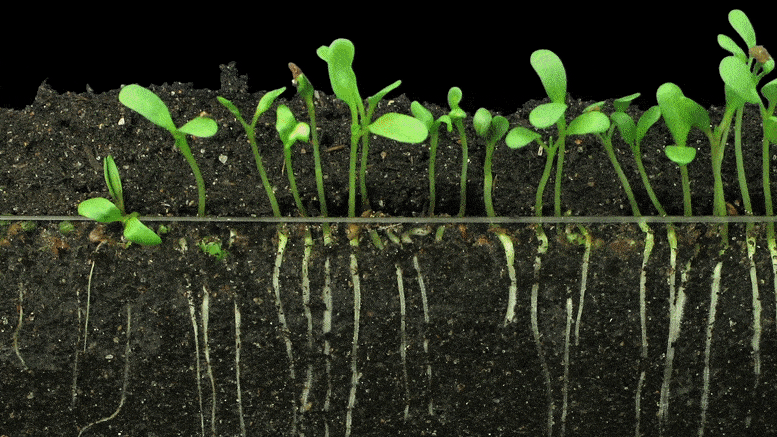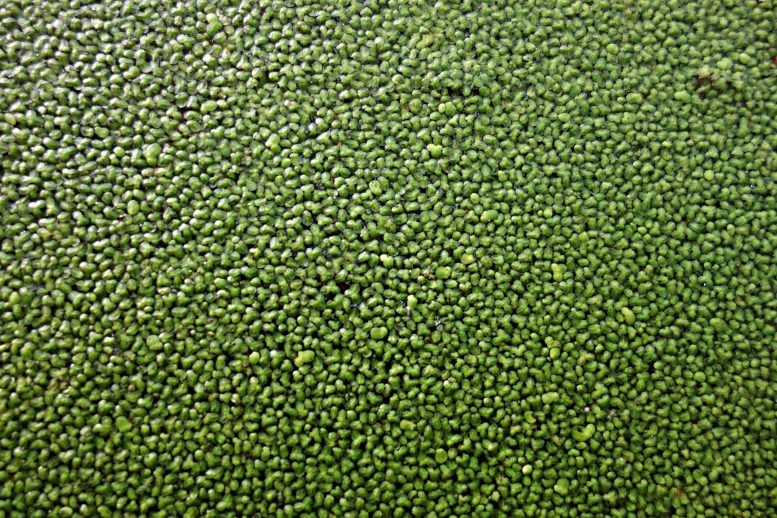
Salk researchers discover that miniature aquatic plant provides insight into genome design principles that could enable development of next-generation crops.
Wolffia, also known as duckweed, is the fastest-growing plant known, but the genetics underlying this strange little plant’s success have long been a mystery to scientists. Now, thanks to advances in genome sequencing, researchers are learning what makes this plant unique–and, in the process, discovering some fundamental principles of plant biology and growth.
A multi-investigator effort led by scientists from the Salk Institute is reporting new findings about the plant’s genome that explain how it’s able to grow so fast. The research, published in the February 2021 issue of Genome Research, will help scientists to understand how plants make trade-offs between growth and other functions, such as putting down roots and defending themselves from pests. This research has implications for designing entirely new plants that are optimized for specific functions, such as increased carbon storage to help address climate change.
“A lot of advancement in science has been made thanks to organisms that are really simple, like yeast, bacteria and worms,” says Todd Michael, first author of the paper and a research professor in Salk’s Plant Molecular and Cellular Biology Laboratory. “The idea here is that we can use an absolutely minimal plant like Wolffia to understand the fundamental workings of what makes a plant a plant.”

Wolffia, which is found growing in fresh water on every continent except Antarctica, looks like tiny floating green seeds, with each plant only the size of a pinhead. It has no roots and only a single fused stem-leaf structure called a frond. It reproduces similar to yeast, when a daughter plant buds off from the mother. With a doubling time of as little as a day, some experts believe Wolffia could become an important source of protein for feeding Earth’s growing population. (It’s already eaten in parts of Southeast Asia, where it’s known as khai-nam, which translates as “water eggs.”)
To understand what adaptations in Wolffia‘s genome account for its rapid growth, the researchers grew the plants under light/dark cycles, then analyzed them to determine which genes were active at different times of the day. (Most plants’ growth is regulated by the light and dark cycle, with the majority of growth taking place in the morning.)
“Surprisingly, Wolffia only has half the number of genes that are regulated by light/dark cycles compared to other plants,” Michael says. “We think this is why it grows so fast. It doesn’t have the regulations that limit when it can grow.”
The researchers also found that genes associated with other important elements of behavior in plants, such as defense mechanisms and root growth, are not present. “This plant has shed most of the genes that it doesn’t need,” Michael adds. “It seems to have evolved to focus only on uncontrolled, fast growth.”

“Data about the Wolffia genome can provide important insight into the interplay between how plants develop their body plan and how they grow,” says HHMI Investigator and Professor Joseph Ecker, who is also director of Salk’s Genomic Analysis Laboratory and a coauthor of the paper. “This plant holds promise for becoming a new lab model for studying the central characteristics of plant behavior, including how genes contribute to different biological activities.”
One focus of Michael’s lab is learning how to develop new plants from the ground up, so that they can be optimized for certain behaviors. The current study expands knowledge of basic plant biology as well as offers the potential for improving crops and agriculture. By making plants better able to store carbon from the atmosphere in their roots, an approach pioneered by Salk’s Harnessing Plants Initiative, scientists can optimize plants to help address the threat of climate change.
Michael plans to continue studying Wolffia to learn more about the genomic architecture of plant development by using this simplified plant to understand the networks that control fate.
Reference: “Genome and time-of-day transcriptome of Wolffia australiana link morphological minimization with gene loss and less growth control” by Todd P. Michael, Evan Ernst, Nolan Hartwick, Philomena Chu, Douglas Bryant, Sarah Gilbert, Stefan Ortleb, Erin L. Baggs, K. Sowjanya Sree, Klaus J. Appenroth, Joerg Fuchs, Florian Jupe, Justin P. Sandoval, Ksenia V. Krasileva, Ljudmylla Borisjuk, Todd C. Mockler, Joseph R. Ecker, Robert A. Martienssen and Eric Lam, 23 December 2020, Genome Research.
DOI: 10.1101/gr.266429.120
Other authors on the study were Nolan Hartwick, Florian Jupe and Justin P. Sandoval of Salk; Evan Ernst and Robert A. Martienssen of Cold Spring Harbor Laboratory; Philomena Chu, Sarah Gilbert, and Eric Lam of Rutgers, The State University of New Jersey; Douglas Bryant and Todd C. Mockler of Donald Danforth Plant Science Center; Stefan Ortleb, Joerg Fuchs, and Ljudmylla Borisjuk of Leibniz Institute of Plant Genetics and Crop Plant Research in Germany; Erin L. Baggs and Ksenia V. Krasileva of the University of California, Berkeley; K. Sowjanya Sree of Central University of Kerala, in India; and Klaus J. Appenroth of Friedrich Schiller University of Jena, in Germany.
This work was funded by the US Department of Energy, Office of Science, Office of Biological and Environmental Research program. It was also supported by a grant from the Hatch project from the New Jersey Agricultural Experiment Station at Rutgers University and the Howard Hughes Medical Institute.